Rajasthan Board RBSE Class 12 Biology Chapter 40 Important and Common Human Diseases
RBSE Class 12 Biology Chapter 40 Multiple Choice Questions
Question 1.
In which of the following disease, deformities in fingers are generated?
(a) Tetanus
(b) Leprosy
(c) Tuberculosis
(d) Pneumonia
Answer:
(b) Leprosy
![]()
Question 2.
Which among the following viruses, cause AIDS?
(a) Poliovirus
(b) HIV
(c) Rabies
(d) Chickenpox
Answer:
(b) HIV
Question 3.
Kala-azar disease is caused by –
(a) Entamoeba histolytic
(b) Leishmania
(c) Trypanosoma
(d) Plasmodium
Answer:
(b) Leishmania
![]()
Question 4.
Malaria is caused by biting of the following mosquito.
(a) Male Anopheles
(b) Female Anopheles
(c) Culex
(d) Tsetse fly
Answer:
(b) Female Anopheles
Question 5.
Guinea-Worm disease is caused by –
(a) Dracunculus
(b) Ascaris
(c) Enterobius
(d) Taenia
Answer:
(a) Dracunculus
Question 6.
Treatment of which of the following diseases is possible only in initial stages.
(a) Cancer
(b) Asthma
(c) Emphysema
(d) Allergy
Answer:
(a) Cancer
![]()
Question 7.
Which of the following is a genetic disease?
(a) sickle cell Anaemia
(b) Haemophilia
(c) Colour Blindness
(d) All the above
Answer:
(d) All the above
RBSE Class 12 Biology Chapter 40 Short Answer Type Questions
Question 1.
What do you understand by contagious diseases? Give two examples.
Answer:
Contagious diseases:
These diseases in a healthy person are caused through direct contact with an infected person.
Example: Ringworm, Conjunctivitis.
![]()
Question 2.
Write a short note on Acquired Immuno Deficiency Syndrome.
Answer:
Acquired Immuno Deficiency Syndrome (AIDS):
1. General:
- It is a viral infectious disease which is caused by HIV (Human immunodeficiency virus) or HTLV-3 (Human T-Lymphocyte virus-3) or LAV (Lymphadenopathy associated virus).
- This virus belongs to the retrovirus family.
- This virus was discovered by Montagnier (1982).
- This virus infects helper T-lymphocytes.
- This virus does not survive in the air.
- It destroys the infected CD or T-cells. which are formed in the thymus during childhood?
- A healthy man contains about 300-400 million T4 cells.
2. Structure of HIV:
- AIDS virus is an RNA retrovirus. Its RNA forms DNA in a host cell.
- Structurally, AIDSA virus is bounded by a bilayer of phospholipids in which GP-120 & GP-41 glycoproteins remain embedded. It has 2 single-stranded RNA molecules & each RNA is attached with a reverse transcriptase enzyme. There are two protein layers around the RNA molecules viz.-P-24 proteins (Inner) & P-17 proteins (outer).
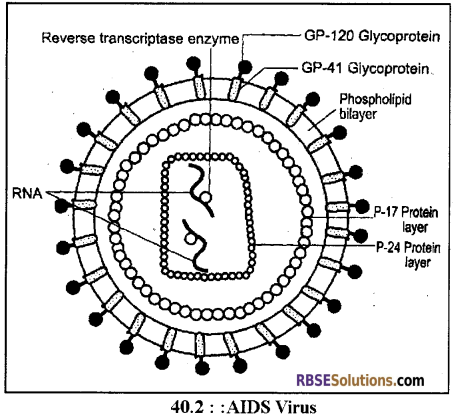
- With the help of reverse transcriptase enzyme, HIV can synthesis DNA from RNA. Two subtypes of HIV has been found-HIV-1 and HIV-2. HIV 1 is responsible for AIDS.
3. Modes of Infection of HIV:
- Infection takes place by blood contact.
- Infection is possible by sexual contact.
- The virus infects embryo in the uterus, as in filters through the endometrium of the uterus.
- This virus is also found in the colostrum.
- Maximum 80% transmission occurs homosexuality
4. Symptoms:
- Constant loss of body weight.
- Prolonged diarrhoea.
- Prolonged fever.
- Swelling of lymph nodes.
- Prolonged coughing.
- An aids-infected person normally develops Pneumocystis carinae pneumonia and Kaposi sarcoma.
- Profuse sweating.
![]()
Question 3.
Write short notes on:
- Amoebiasis
- Malaria
- Guinea worm disease
- Cancer
Answer:
1. Amoebiasis:
- Amoebiasis disease is also called as Amoebic dysentery.
- This is caused by a protozoan called Entamoeba histolytic.
Symptoms:
- In this disease, the pathogen in its trophozoite stage enters in the intestinal wall and secretes tissue decomposing enzymes which cause disintegration of cells.
- This results in small mucus-filled ulcers in the affected area.
- The ulcers bursts in the lumen of the intestine and release mucus which comes out along with the faces.
- The patient does not suffer from fever, however, he develops diarrhoea with abdominal cramps throughout the day.
- Some times blood also comes out along with stool. Patients become very weak.
- Mode of Infection: It spreads through food, water and flies.
- Prevention: For prevention from this disease we, boiled water, we must not consume uncovered food.
- Treatment: For the treatment of this disease Amitine, Fusegilin, metronidazole medicine are available.
2. Malaria Fever:
- This disease is caused by various species of Plasmodium which are as follows:
- Plasmodium vivax: Most common
- Plasmodium falciparum: Most dangerous
- Plasmodium malaria
- Plasmodium ovule
- The transmission of the disease is through biting of female Anopheles mosquito.
- Life Cycle of Plasmodium:
- The life cycle of Malaria parasite is digenetic. It is divided into three phases:
- Schizogony Asexual ⇒ Human liver cells & RBC.
- Gamogony 3 Sexual ⇒ Begins in Man and completes in female Anopheles.
- Sporogony ⇒ Asexual; Stomach of female Anopheles.
- The life cycle of Malaria parasite is digenetic. It is divided into three phases:
- The Schizozogony is further divided into four phases:
- Preerythrocytic phase: Human Liver Cells.
- Exoerythrocytic phase: Human Liver Cells.
- Erythrocytic phase: Human RBC.
- Postertythrocytic phase: Human liver cells.
- Infective Stage: The infective stage in Man is sporozoite.
- Through biting of female Anopheles mosquito, sporozoite of Plasmodium enters in the blood and multiplies in the liver cells and red blood corpuscles.
- Haemozine is produced which results in Shivering, Chills and Fever.
- The parasite in its gametocyte phase enters in the mosquito when a mosquito bites an infected person.
- Further maturation of the parasite occurs in female Anopheles.
- Male & Female gametocyte through the process of gametogenesis produces male and female gametes.
- The gametes fuse and to form a zygote. The zygote divides and forms new sporozoites that migrate to the salivary gland of the mosquito.
- When the mosquito bites a person, the sporozoites enter his body. For the treatment of this disease medicines containing antimony compounds are used.
Symptoms:
Release of haemozoin along with merozoites causes malaria symptoms or paroxysm viz.,
- Rigour stage: Patient experience chill and shivering.
- Fibril stage: Body temperature rises to 104-106°F.
- Defervescent stage: Profuse sweating. It occurs 6hrs. after rigour stage.
Medicines:
- Quinine is the oldest known medicine for the treatment of malaria fever. It is obtained from the bark of the Cinchona tree. This tree is found in Peru, Shri Lanka. Java, India etc.
- Other useful medicines are Nivaquin, Resochin, Camaquin, Chloroquine, Paludrin, Plasmaquin, Daraprim, Mapacrine etc. Sulfadoxine & Pyrimethanine are the new & most effective medicines. Nowadays a single dose of sulfadoxine 750 mg. & Pyrimethamine 37.5 mg. is given.
Prevention:
- According to National malaria eradication programme (NMEP), malaria control involves three methods viz. destruction of mosquitoes, prevention from infection & treatment of patients.
- Destruction of mosquito larvae using fishes is called as biological control of malaria.
- Stickle back, Gambusia, Minnows, Trout, Channa etc. are some Larvicidal fishes.
- Allethrin is the most recent mosquitocidal chemical. 3.6% of allethrin is used in various trademarks like All out, Goodnight, Jet etc. Other common insecticides are Pyrethrum, BHC, DUT, Nephella etc. –
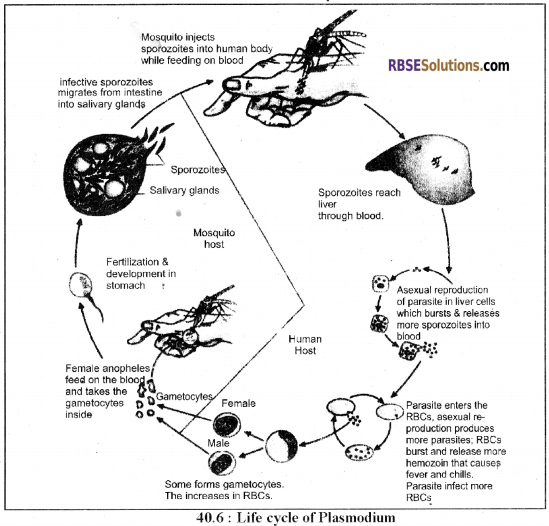
3. Dracunculiasis:
- This disease is caused by a worm called Dracunculus. This pathogen is also called as Guinea Worm or Naru worm. In humans, this worm resides beneath the layer of subcutaneous tissues of arms, legs and shoulder skin.
Symptoms:
- In the effort to release the embryo, the bearing female tries to move out of the skin. The area of skin from where it attempts to move out suffers from itching and inflammation.
- The poisonous substances released by the female worm forms small ulcer or blister through which the posterior portion of the female worm comes out to release young ones. Local inflammation, swelling and pain are associated with this process. Blisters get cured in a few days.
Treatment:
- For the treatment, the worm is removed through surgery. In villages, the worm is removed with the help of a wooden stick.
- Villages do it very carefully by wrapping and pulling the worms which are peeping out of the skin on the wooden stick. In this process, there are many chances of breaking of the worm inside the body.
4. Cancer:
- It is a complex disease which may occur in any body part.
- Cell division in the human body is a normal feature but as and when the regulatory process of the division gets disturbs, the cells start to divide in an uncontrolled manner. i.e. cancer is a stage when “cell gets mad”.
- This results in the formation of a cellular lump which is called as Tumour.
- Lung cancer is the most common in human beings.
- In women, mammary cancer is most common.
RBSE Class 12 Biology Chapter 40 Essay Type Questions
Question 1.
Name Non-communicable diseases. Explain any two of them in detail.
Answer:
Non-Infectious Diseases:
- Such diseases are not caused by infection, therefore they are called as non-infectious diseases. Some of them are as follows:
Cancer:
- It is a complex disease which may occur in any body part.
- Cell division in the human body is a normal feature but as and when the regulatory process of the division gets disturbs, the cells start to divide in an uncontrolled manner. i.e. cancer is a stage when “cell gets mad”.
- This results in the formation of a cellular lump which is called as Tumour.
- Lung cancer is the most common in human beings.
- In women, mammary cancer is most common.
Types of Tumour It is of two types:
- Benign Tumour: They are generally confined to the point of origination and do not have the ability to spread to other parts of the body. They are not detrimental.
- Malignant Tumour: Malignant tumours are called cancerous. They can spread from one part to another part of the body. The new tumour starts to appear at different places which are called Metastasis.
Diagnosis:
- Precancer stage & tumour stage of cancer can be investigated on the basis of the following symptoms:
- Any swelling or blister or boil which do not cure or reoccurs after getting cured.
- Fluidity discharge from somebody orifice in a continuous or periodic manner.
- Presence of some lump of tissue in an organ or lump like structure. It occurs with breast cancer.
- Indigestion or Irregularity in the stomach which occurs repeatedly. Severe constipation and diarrhoea which may get cured but appears repeatedly.
- Sudden loss of body weight.
- Regular coughing or sore throat for a long time.
- The diagnosis of cancer is based upon biopsy and by counting an increase in the number of a cell of blood or bone marrow examination is done. (In case of Leukemia or blood cancer).
- Biopsy of a doubtfull tissue is carried out for microscopic examination of the stained thin sections & pathology is observed.
- Radiography (using X-ray), computed tomography and magnetic tomography etc. are some techniques which are used for the detection of cancer in internal organs.
- For detection of a certain type of cancers, specific antibodies are used against cancer-specific antigens. MRI requires the use of a strong magnetic field while X-rays (ionizing radiations) are used for radiography.
Types of Cancer:
- On the basis of affected tissue, cancers are of different types, such as –
- Carcinoma: Cancer originating from epithelial cells are called Carcinoma. They normally originate on the skin and internal organs surface.
- Sarcoma: Such cancers originates from connective tissues. They are normally associated with the mesodermic structures.
- Osteoma: Cancers associated with bones are called Osteoma.
- Fibroma: Cancers associated with filamentous tissues are called fibroma.
- Glioma: Such cancers are associated with the connective tissues of the nervous system and brain.
- Melanoma: They are the fast-growing pigmented tumour on the skin. It is caused by excess growth of melanocytes.
- Lymphoma: Cancers which arises in lymph nodes and other tissues of the lymphatic system are called lymphoma.
Treatment of Cancer:
- Tools of molecular biology are used to find out the genes responsible for cancer. Identification of such genes is essential which predispose the person for cancer
Treatment. - The following are some treatment procedures –
- Radiotherapy: In this treatment cancer cells are destroyed by using radiation.
- Chemotherapy (Chemical treatment): In this therapy, cancer cells are treated with anticancer medicines. Alopecia and anaemia are the major side effects of this treatment.
- Nowadays most of the cancer treatments are based upon a combination of surgery, radiotherapy, and chemotherapy. Interferons are also used to destroy cancer cells. Interferons activate the immune system which in turn destroy the cancer cells.
Causes of Cancer:
- The factors which cause the conversion of normal cells into cancer cells are called Carcinogens. Some of them are as follows:
- Ionizing and Non-ionizing Radiations:
Examples: X rays, Gama Rays, UV rays etc. - Physical Stimuli: Such as Kangri used in Kashmir.
- Chemical Factors: Testosterone, Caffein, Estrogen, Cigar, Tobacco products, heavy metals mustard gas etc.
- Biological factors: Oncoviruses: Ejstine Barr virus, Herpes simplex virus, SV-40 virus etc.
- Oncogenes.
- Ionizing and Non-ionizing Radiations:
Allergy or Hypersensitivity:
- The body responds characteristically to some substances i.e. the body is hypersensitive to some substances which are called as an allergy.
- The substances which cause allergy are called allergens. For examples carbon particles, pollen granules, dust particles, some proteins etc.
- Term “allergy” was coined by Parquet.
- The allergy is of 4 types –
- Anaphylactic reactions
- Cytotoxic reactions
- Toxic-complex syndrome reactions
- Delayed-hypersensitivity cell-mediated reactions
- In allergy, the mast cells secrete histamine. In mast cells, the histamine is found in the form of inactive histidine.
- The mast cells also secrete serotonin which is secreted in the allergy caused by food. It causes muscles contraction & increases cellular permeability.
- Antihistamines & steroids give fast relief in allergy.
- IgE type of antigen is generally produced against allergens. Running nose, sneezing and coughing, difficulty in respiration are some of the symptoms of allergy.
![]()
Question 2.
Explain some of the Protozoan mediated diseases.
Answer:
1. Amoebiasis:
- Amoebiasis disease is also called as Amoebic dysentery.
- This is caused by a protozoan called Entamoeba histolytic.
Symptoms:
- In this disease, the pathogen in its trophozoite stage enters in the intestinal wall and secretes tissue decomposing enzymes which cause disintegration of cells.
- This results in small mucus-filled ulcers in the affected area.
- The ulcers bursts in the lumen of the intestine and release mucus which comes out along with the faces.
- The patient does not suffer from fever, however, he develops diarrhoea with abdominal cramps throughout the day.
- Some times blood also comes out along with stool. Patients become very weak.
- Mode of Infection: It spreads through food, water and flies.
- Prevention: For prevention from this disease we, boiled water, we must not consume uncovered food.
- Treatment: For the treatment of this disease Amitine, Fusegilin, metronidazole medicine are available.
2. Diarrhoea/Giardiases:
- It is a protozoan disease which is caused by a flagellated protozoan named Giardia. This enters into the body along with water, food etc. and reaches up to the intestine.
Symptoms:
- This leads to functional irregularities in the intestine.
- Patients suffer from loose motion.
- Stomachache & reduced appetite.
- Headache and restlessness.
Treatment:
- For the treatment of this disease, drugs such as chloroquine, camping, Atrobin etc. are administered.
3. Trypanosomiasis:
- It is also called as Sleeping sickness. This disease is caused by Trypanosoma ambience. It is transmitted through a Tsetse fly (Glossina Palais).
- This protozoa enter in the lymphatic system of our body and secretes poisonous substances. Which results in swelling of the lymphatic system
- Trypanosoma enters in the cerebrospinal fluid and causes malfunctioning of the brain.
- Symptoms: Patient remains in a sleepy state.
- Treatment: For the treatment of this disease Primaquine and Puromycin drugs are used.
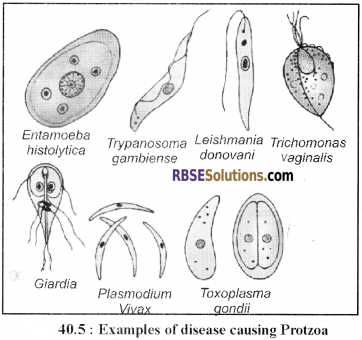
4. Malaria Fever:
- This disease is caused by various species of Plasmodium which are as follows:
- Plasmodium vivax: Most common
- Plasmodium falciparum: Most dangerous
- Plasmodium malaria
- Plasmodium oval
- The transmission of the disease is through biting of female Anopheles mosquito.
- Life Cycle of Plasmodium:
- The life cycle of Malaria parasite is digenetic. It is divided into three phases:
- Schizogony Asexual ⇒ Human liver cells & RBC.
- Gamogony 3 Sexual ⇒ Begins in Man and completes in female Anopheles.
- Sporogony ⇒ Asexual; Stomach of female Anopheles.
- The Schizozogony is further divided into four phases:
- Preerythrocytic phase: Human Liver Cells
- Exoerythrocytic phase: Human Liver Cells
- Erythrocytic phase: Human RBC
- Postertythrocytic phase: Human liver cells.
- Infective Stage: The infective stage in Man is sporozoite.
- Through biting of female Anopheles mosquito, sporozoite of Plasmodium enters in the blood and multiplies in the liver cells and red blood corpuscles.
- Haemozine is produced which results in Shivering, Chills and Fever.
- The parasite in its gametocyte phase enters in the mosquito when a mosquito bites an infected person.
- Further maturation of the parasite occurs in female Anopheles.
- Male & Female gametocyte through the process of gametogenesis produces male and female gametes.
- The gametes fuse and to form a zygote. The zygote divides and forms new sporozoites that migrate to the salivary gland of the mosquito.
- When the mosquito bites a person, the sporozoites enter his body. For the treatment of this disease medicines containing antimony compounds are used.
Symptoms:
Release of haemozoin along with merozoites causes malaria symptoms or paroxysm viz.,
- Rigour stage: Patient experience chill and shivering.
- Fibril stage: Body temperature rises to 104-106°F.
- Defervescent stage: Profuse sweating. It occurs 6hrs. after rigour stage.
Medicines:
- Quinine is the oldest known medicine for the treatment of malaria fever. It is obtained from the bark of the Cinchona tree. This tree is found in Peru, Shri Lanka. Java, India etc.
- Other useful medicines are Nivaquin, Resochin, Camaquin, Chloroquine, Paludrin, Plasmaquin, Daraprim, Mapacrine etc. Sulfadoxine & Pyrimethanine are the new & most effective medicines. Nowadays a single dose of sulfadoxine 750 mg. & Pyrimethamine 37.5 mg. is given.
Prevention:
- According to National malaria eradication programme (NMEP), malaria control involves three methods viz. destruction of mosquitoes, prevention from infection & treatment of patients.
- Destruction of mosquito larvae using fishes is called as biological control of malaria.
- Stickle back, Gambusia, Minnows, Trout, Channa etc. are some Larvicidal fishes.
- Allethrin is the most recent mosquitocidal chemical. 3.6% of allethrin is used in various trademarks like All out, Goodnight, Jet etc. Other common insecticides are Pyrethrum, BHC, DUT, Nephella etc. –
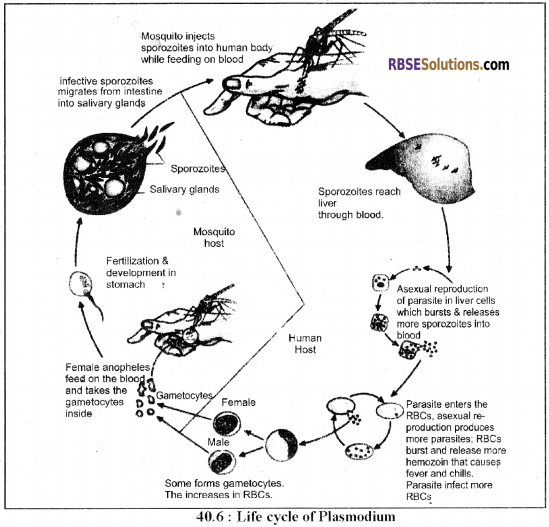
5. Leishmaniasis (Kala-Azar):
- This disease is caused by different various of Leishmania. It is a flagellar parasite which is found in the blood of vertebrates. Kala-Azar is caused by Leishmania Donovan.
- The vector host is sand fly (Phelobotomus)
Symptoms:
- The pathogens of this disease block the Reticuloendothelial system, as a result, the spleen enlarges in size. It forms boil like bulges all over the body especially in the nasal, oral and pharyngeal regions.
6. Trichomoniasis:
- This disease is caused by various species of Trichomonas. It is a flagellar protozoan.
- The most common species of Toxoplasma is Trichomonas vaginal.
- This pathogen resides in the vagina of women and causes vaginitis disease in them.
- Symptoms: This disease cause secretion of a foamy substance from the vagina. This also causes itching and inflammation in the vagina.
7. Toxoplasmosis:
- This disease is caused by Toxoplasma Gondi which is a Sporozoa protozoan. This pathogen is pandemic.
- Symptoms: This pathogen is found in the cells of the reticuloendothelial system and the central nervous system of humans. Hydrocephalus and chorioretinitis are major symptoms of this disease.
![]()
Question 3.
What are communicable diseases? Explain any two communicable diseases.
Answer:
Infectious Diseases:
- The diseases which are caused by some pathogens (Bacteria/viruses/Other animals).
- They are capable of being transmitted from person to person.
- Their infection is through air or food or water or blood contact or body contact or other vectors.
Diseases caused by Bacteria:
- Leprosy or Hansen’s Diseases:
- It is caused by the infection of Mycobacterium leprae bacteria.
- In this disease, the nervous system, muscle, skin etc. gets badly affected. The symptoms of the disease start to appear from 1 to 7 years.
- The disease spreads through the discharge released from wounds. Staying with the patient for a long time may also spread the disease. Leprosy is found only in humans. Symptom: Deformatiy in finger & toes.
- Type: Leprosy is mainly of three types –
- Tuberculoid:
- A patient suffering from tuberculoid leprosy has high immune power.
- In this disease scales and wounds appear on the skin. The hands-legs and fingers twists (bends).
- Lepromatous:
- Patients suffering from Lepromatous leprosy disease have compromised immune power.
- In this disease bacterial cells aggregates and appear in the form of Globi. Lumps emerge on the surface.
- Very high numbers of wounds are also seen in such patients.
- Borderline:
- Patients suffering from Borderline Leprosy exhibit symptoms of both tuberculoid and lepromatous leprosy. Skin becomes scaly, lumps emerges and wounds also appears.
- Tuberculoid:
Prevention:
- Patients suffering from leprosy should be kept in isolation from healthy normal people.
- Clothes & other belongings used by them should not be used by others.
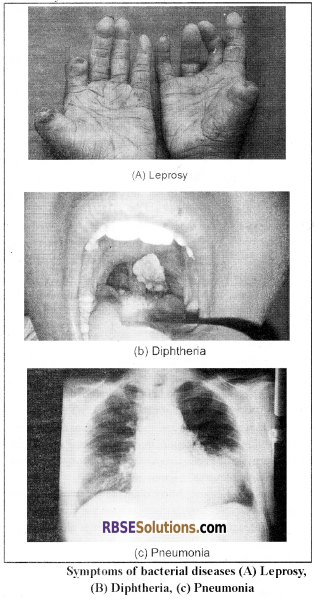
2. Tuberculosis:
- It is an infectious disease caused by Mycobacterium tuberculosis bacteria.
- These bacteria can infect any body part bill commonly infect lungs.
- The infection occurs mainly by droplets. Also spreads through water.
- These bacteria release a toxin called tuberculin which degenerates body tissues.
- Test: Mantoux test
Symptoms:
- This disease results in a cough and fever. Bodyweight decreases and man feel tiredness. The eyes get stuck inside.
- Appetite decreases, as a result, the person becomes weak.
- Germs of the pulmonary TB enters in the atmosphere through spitting, mucus, sneezing and sputum of the diseased person and through respiration, these germs enter in the body of any healthy person.
- When there is less immunity in the body then the pathogens multiply very rapidly and comes out with sputum. Some times blood also appears in the sputum.
Prevention:
- The person should take special precautions to protect himself from the disease. The diseased person should be kept in isolation.
- His clothes, utensils etc. should be cleaned by boiling using water. The sputum, stool etc. of the diseased person should be put down in the soil.
- One should not use hookah, beedi, cigarette etc. used by others.
Vaccination:
- Complete prevention is possible by BCG (Bacille Calmette Guerin) Vaccine.